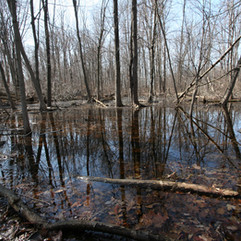Whispers of Spring: The Enchantment of Vernal Pools
- Anastasia Alexandrova
- Apr 1
- 5 min read
Learn about the key characteristics and ecological benefits of vernal pools in Michigan, and how you can help increase the research and conservation of these small yet significant, biodiverse wetlands.

What is bigger than a puddle, smaller than a lake, only exists in the spring, and has fairies living in it? It’s not a mystical pond—instead we call it a vernal pool. But this special wetland is nothing short of magic. If you have ever come across a small, random body of water in a wooded area, you may have very well crossed paths with a vernal pool. Vernal pools, also called seasonal or ephemeral pools, are defined as naturally occurring shallow depressions that hold water in the late winter and/or springtime. They are found in glaciated areas of the northeastern and midwestern US. Blue Heron Headwaters Conservancy maintains several properties that protect a number of vernal pools within them.
Due to a lack of awareness and education of the immense ecological benefits that vernal pools provide, they can easily be overlooked during the planning and development of land, and are therefore decreasing across the nation. Many organizations and individuals are working hard to rapidly increase data collection, education, and protection of vernal pools, such as the recently implemented Vernal Pool Patrol monitoring program from Michigan State University.
There are five key characteristics that distinguish a vernal pool from other wetlands. First, vernal pools are seasonally flooded; Specifically for Michigan, they hold water for at least 2 months in the springtime. Second, they are small and shallow. They are generally characterized by being less than 2.5 acres, but the majority of vernal pools are actually smaller than 0.25 acres, and most are less than 3 ft deep. Vernal pools source their seasonal water from precipitation, groundwater, surface runoff, overbank flooding, and intermittent streams.
Third, they are geographically isolated, meaning that it is a confined basin with no continuous surface water connection to permanent water. Vernal pools may only have a temporary connection as they are filled in the spring. Vernal pools can be found in all forest types; upland, lowland, coniferous, and deciduous. They require a specific set of conditions to occur which depend on the landscape’s water sources, topography, soil, geology, vegetation, and climate.
Fourth, vernal pools lack fish. The absence of fish predation allows for unique organisms to occur and reproduce in vernal pools. This leads to the fifth and final key characteristic: the presence of indicator species. These are fairy shrimp, wood frogs, spotted salamanders, and blue-spotted salamanders. Indicator species are named so because they rely on vernal pools for their survival. These four indicator species are also among the first organisms to emerge in vernal pools in the spring. Other amphibians also use vernal pools for nursery habitat, such as the small-mouthed salamanders, marbled salamanders, four-toed salamanders, eastern tiger salamanders, and western chorus frogs. While not completely relying on vernal pools, many additional species such as spring peepers, green frogs, eastern newts, redback salamanders, and gray treefrogs are found using vernal pools for food, habitat, and nurseries.
Vernal pools are a big part of tiny life. Aquatic invertebrates that have been found to rely on vernal pools include mollusks (snails, slugs, fingernail clams), crustaceans (crayfish, amphipods, aquatic pill bugs, fairy shrimp, water fleas, clam shrimp, seed shrimp, copepods) and aquatic insects (mosquitos and midges, beetles, true bugs, dragonflies, damselfly nymphs, caddisflies, water mites, and worms). In addition to amphibians and invertebrates, over 550 wildlife species have been found using vernal pools in the northeast US. This includes rare species and Species of Special Concern, like the Blanding’s and spotted turtles and the copperbelly water snake.
The plants growing in a vernal pool dictate the food and habitat structure used by aquatic organisms, as well as the biological and chemical qualities of the pool. Plants provide approximately 60% of the pool’s nutrients. Leaves and twigs decompose in the pool and become food for shredders, grazers, detritivores, fungi, and bacteria. Vegetation in the vernal pool also defines the pool type. An open pool has <30% vegetation cover, a marshy pool has >30% emergent cover, a shrubby pool has >30% shrubby cover, and a forested pool has >30% tree cover.
Woodland plants growing in vernal pools exhibit adaptations which allow them to survive in water for some part of their life cycle. Vernal pool plant adaptations include: Floating (i.e. duckweed), where air sacs help the plant float up to reach the surface and participate in atmospheric gas exchange; Submergence (i.e. water parsnip, coontail), where the roots are modified to anchor the plant down into the water and where the plant grows filamentous leaves to facilitate gas exchange in the water; Emergence (i.e. skunk cabbage, jewelweed), which is a hybrid where the plant begins submerged in the water and grows up and out of the water. Large lenticels on shrubs and buttress roots on trees are other common examples of plant adaptations in vernal pools.
The quality of the landscape and habitat surrounding vernal pools has been found to affect wildlife use, abundance and survival in vernal pools. A study by Michigan State University revealed that wood frogs exhibit a need for several different habitats throughout the year within reachable distances. After spending spring in vernal pools, the wood frogs move to nearby forested wetland to spend summer there. Then, the frogs move to upland habitat forest in the fall and winter before returning to vernal pools in the spring. It’s been found that larger, unfragmented wetland clusters and the biodiversity of clusters are associated with greater species richness, abundance, and persistence of amphibians using vernal pools. Vernal pools are a great example of ecosystem interconnectedness and the importance of land connectivity in conservation.
Vernal pools are an important type of Michigan wetland because they provide critical habitat for wildlife, ecosystem services, and social and educational value. They are easy systems to access, collect data on and learn about for all ages. They provide nutrient cycling, flood/erosion control, water storage and infiltration, groundwater recharge, improved water quality, and carbon storage for their connected forested ecosystems. But vernal pools have very limited information, general public awareness, and protection from current state regulations. This is partly because they can be difficult to identify, especially for the majority of the year during their dry season.
In an attempt to fill this gap in research and public understanding of vernal pools, the Michigan Vernal Pools Partnership was initiated by Michigan State University/Michigan Natural Features Inventory in 2015. This is a public/private partnership of nonprofits, businesses, individuals, agencies, and conservancies including Blue Heron Headwaters Conservancy. The partnership is looking for people like you to join their Michigan Vernal Pool Patrol monitoring program to become a community scientist and volunteer to help collect data, develop maps, and monitor vernal pools in Michigan. A virtual training series and field training is available for anyone to complete online for free until May 2nd. Access the training and learn more about the Michigan Vernal Pool Patrol monitoring program here: https://vernal-pool-patrol-mnfi.hub.arcgis.com/pages/trainings
Learn more about the Michigan Vernal Pools Partnership and the Vernal Pool Patrol, the community-science arm of the partnership:
The information in this blog was sourced from the 2025 Michigan Vernal Pool Training Series parts 1, 2, and 3. https://vernal-pool-patrol-mnfi.hub.arcgis.com/pages/trainings
This Earth Day
The Blue-spotted salamander, one of the four indicator species of Michigan vernal pools, needs your support to thrive in its unique home. This Earth Day, you have the power to protect the land, water, and wildlife that makes our region special. On April 22nd, join us for A Day of Giving—a chance to give back to the Blue-spotted salamander and to the land that gives us everything. Your donations, volunteering, sharing our content, and spreading the word of our mission is essential for Blue Heron Headwaters Conservancy to preserve open spaces, restore vital habitats, and ensure a future where nature thrives. Every gift and every action makes an impact. Be a part of something bigger this Earth Day!
Give on Earth Day



















